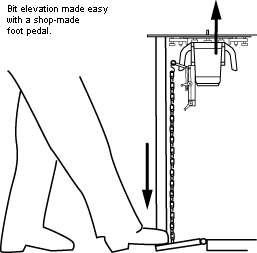Plunge router in router table?
It is definitively possible (and safe).
You should make sure your router has enough power, though. A router of the "1000W class" is not very suitable, although it is of course still possible to use it in a router table.
However, first of all, it will be a bit weak, and on top of that the smaller models have a smaller routing stroke. You will, depending on the construction, lose anywhere from 3mm to 10mm because you have to subtract the plate's thickness. So, with a little router that maybe only has 45-50mm stroke total, you may end up with something that soon reaches its physical limits.
Using a "middle class" router (1400W) which usually have 65-70mm stroke works fine, and of course a 2200W router will rock (they tend to have another 20-30mm of routing stroke extra).
At least three DIY manufacturers that I know and two German professional-grade manufacturers (Festool and Maffel) build router tables exclusively with plunge routers. That demonstrates that it's not just possible, but actually someting that works.
You can of course build one yourself at a fraction of the cost. Basically what you need is a plate (resin coated multiplex is fine) with a hole, and four legs. And well, a vertical stop that locks in a t-ridge, with a piece of plexiglass on top for safety.
Using a standard $25 scissor car lifter (as shown here) provides a very easy way of adjusting depth. You can either fix the router in the plate with a few screws, or you can plug two fitting steel rods that are fixed in the table into the holes where the parallel guide is normally mounted (the holes are made for that purpose, so no worries there).
Much more sophisticated builds are possible, of course... I'll leave that for homework.
Am I doing something wrong
It sounds at least unusual that a router should be so stubborn. I almost always operate with two hands on the handles to be on the safe side (if both hands are on the handles, no hand can be somewhere else, this helps keeping your fingers, also fixing the clamp once you've plunged in takes the left hand). But in principle, I could easily, without effort, handle my router with one hand.
From the obvious (forgot to open the screw?), I can only think of needing some cleaning and oil as probable causes.
When opening the clamp (the one that holds the router bit), always be sure to pay attention that you don't hit the steel rods that the router slides on with your wrench. Also, don't close the screw clamp much harder than necessary. It needs to hold firm, but you aren't trying to smith the rod into a different form.
Although they're stainless steel, I could imagine that if one is negligent and keeps squeezing and hammering against them them with the wrench for years, it's possible to make bumps and scratches that impair a smooth slide. But still, making dents into steel should take some continuous abuse, so I don't think that's very likely.
Either way, you'll see if they are nice and smooth after cleaning.



